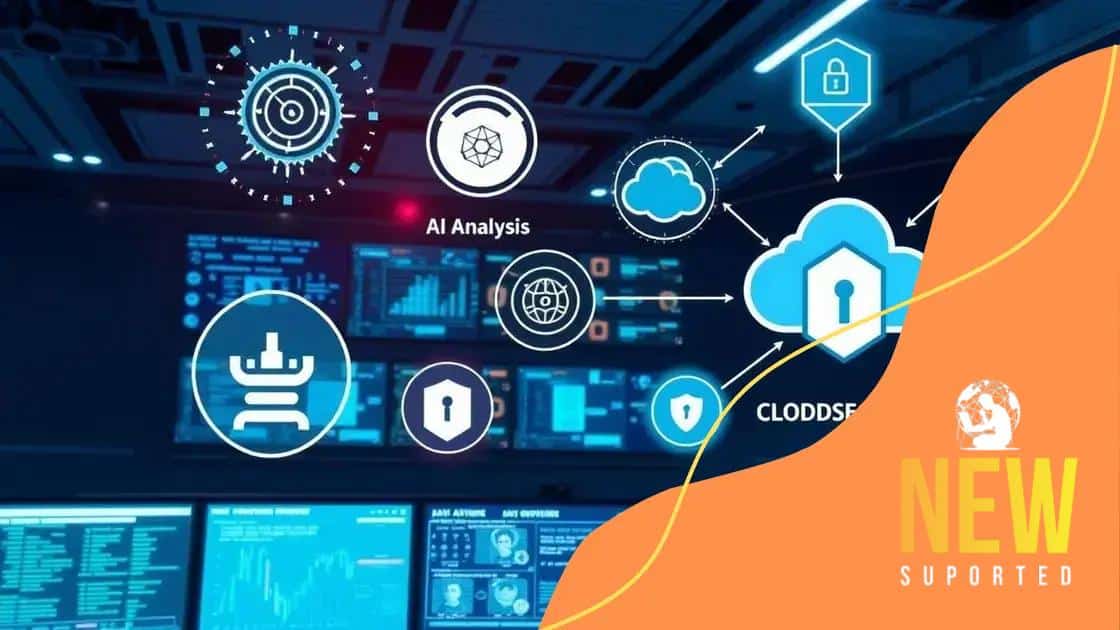International efforts to combat cybercrime in 2025

International efforts to combat cybercrime in 2025 involve enhanced collaboration among nations, improved technology usage, and active participation by individuals to create a safer digital environment.
International efforts to combat cybercrime in 2025 are shaping a safer digital future for everyone. With new threats emerging, how are countries coming together to tackle them? Let’s delve into the strategies and innovations designed to enhance cybersecurity.
The evolving landscape of cybercrime
The world of cybercrime is constantly changing, as new technologies and methods emerge. Understanding the evolving landscape of cybercrime is critical for both individuals and organizations. In this section, we will explore the various forms of cyber threats and how they develop over time.
Types of Cybercrime
There are several prevalent types of cybercrime. These include:
- Phishing: An attempt to trick individuals into providing sensitive information.
- Ransomware: Malicious software that locks a user’s files until a ransom is paid.
- Identity Theft: Illegally obtaining and using someone’s personal information.
- Cyberbullying: Using the internet to harass or intimidate others.
As technology advances, so do the tactics used by cybercriminals. For example, with the rise of the Internet of Things (IoT), hackers can exploit vulnerabilities in connected devices. This means the potential for cybercrime can increase dramatically.
Emerging Technologies and Cybercrime
Artificial Intelligence (AI) and machine learning are being used by both sides in this ongoing battle. Hackers utilize these technologies to launch sophisticated attacks, while cybersecurity experts employ them to develop advanced defense mechanisms. The use of AI enables quicker detection of threats and more efficient responses.
Furthermore, it’s essential to stay informed about how cybercrime evolves. For instance, cybercriminals now often operate in networks, sharing information and tools to improve their methods. This collaborative approach amplifies their ability to create damage and evade law enforcement.
Investing in education and awareness can help combat this evolving threat. Understanding the types of attacks and recognizing phishing scams can significantly reduce the risk of falling victim to cybercrime. Staying updated on the latest threats can empower individuals and organizations to take proactive steps in protecting their data and systems.
Key international collaborations in 2025
In 2025, various international collaborations are emerging to enhance the fight against cybercrime. These partnerships are essential as they unite governments, private sectors, and non-profit organizations to create robust strategies for cybersecurity. By working together, countries can share resources and intelligence to tackle this global issue.
Benefits of International Collaboration
Collaborating internationally provides several advantages:
- Resource Sharing: Nations can pool resources for better cybersecurity measures.
- Information Exchange: Countries can share vital information about threats and vulnerabilities.
- Unified Efforts: A coordinated response enhances the efficiency of combating cybercrime.
- Cultural Insights: Understanding different cultural perspectives can lead to innovative solutions.
As the cybercrime landscape changes, specific programs have been developed to enhance these collaborations. For instance, Europe has established the European Cybercrime Centre to support the investigation and prosecution of cybercriminals. Similarly, organizations like INTERPOL are increasing efforts to connect member countries, sharing databases and intelligence on cyber threats.
Global Initiatives and Frameworks
In addition to specific organizations, several global initiatives focus on harmonizing laws and protocols related to cybersecurity. The United Nations has initiated dialogues to create comprehensive frameworks that protect against cybercrime. These frameworks aim to bring nations together in standardized approaches to tackling cyber threats.
Moreover, training programs and workshops sponsored by international bodies help build skills among law enforcement and cybersecurity professionals. These initiatives ensure that countries are equipped with the knowledge needed to confront the evolving threat landscape.
Through these dedicated efforts, international collaborations in 2025 will aim to create a safer digital environment. It is crucial for individuals and organizations to support these initiatives and stay informed, reinforcing the communal fight against cybercrime.
Technological advancements in cybersecurity

Technological advancements in cybersecurity are crucial for staying ahead of evolving threats. In 2025, we will see significant changes in how organizations protect their digital assets. These advancements not only improve security measures but also reduce the risks associated with cybercrime.
Emerging Technologies
Several key technologies are transforming cybersecurity:
- Artificial Intelligence (AI): AI helps analyze large amounts of data to detect anomalies and threats quickly.
- Blockchain: This technology offers secure transaction methods that are harder to manipulate.
- Quantum Computing: Though still in its infancy, this technology promises to revolutionize data encryption.
- Machine Learning: By learning from previous attacks, machine learning algorithms can predict and prevent future breaches.
As these technologies advance, they will provide businesses with new tools to defend against cybercrime. Utilizing AI and machine learning, organizations can automate threat detection and response.
Cloud Security Innovations
The rise of cloud computing enables businesses to store and manage data more efficiently. However, it also presents unique challenges. In response, advancements in cloud security are becoming more sophisticated. New tools help ensure data integrity and confidentiality in cloud environments.
Multi-factor authentication (MFA) is one such innovation, enhancing user verification processes. Additionally, encryption is becoming more robust, protecting data both at rest and in transit, ensuring it remains secure from unauthorized access.
Staying informed on these technological advancements is vital for both individuals and organizations. Regularly updating software and security protocols can significantly reduce vulnerabilities. Organizations are encouraged to assess their security infrastructure and adopt emerging technologies to safeguard against cybercrime.
Challenges faced by global agencies
Global agencies face numerous challenges in their efforts to combat cybercrime. As technology evolves, so do the tactics of cybercriminals, making it harder for law enforcement and cybersecurity experts to keep up. Understanding these challenges is essential for enhancing international collaboration.
Resource Limitations
One significant challenge is the limitation of resources. Many agencies operate with restricted budgets, which hinder their ability to invest in new technologies and training. This often results in outdated systems that are less effective against modern threats.
Furthermore, the gap between countries can create disparities in capabilities. Some nations have advanced cybersecurity measures, while others lack basic protections. This inequality can lead to vulnerabilities that cybercriminals exploit.
Jurisdictional Issues
Another major obstacle is jurisdictional issues. Cybercrime often crosses borders, making it difficult to investigate and prosecute offenders. Different legal systems and regulations can complicate cooperation between countries. The lack of unified international laws means that perpetrators may evade justice by operating from countries with less stringent regulations.
For instance, if a cybercriminal based in one country attacks a target in another, extraditing them can be a lengthy and contentious process. These legal hurdles slow down enforcement efforts and leave victims without recourse.
Rapid Technological Changes
The rapid pace of technological advancement presents further challenges. New technologies, such as the Internet of Things (IoT) and artificial intelligence, while beneficial, introduce new vulnerabilities. Many agencies struggle to keep their personnel trained on the latest tools and threats, making it easier for cybercriminals to exploit weaknesses.
There’s also the challenge of adapting existing laws and regulations to match these technological shifts. As cybercrime methods grow more sophisticated, global agencies must work quickly to develop policies that reflect the current landscape.
By understanding these challenges, global agencies can better prepare and adapt their strategies to effectively combat cybercrime. Continuous collaboration and sharing of best practices can help overcome these hurdles.
The role of individuals in fighting cybercrime
The role of individuals in fighting cybercrime is increasingly important in today’s digital world. As cyber threats grow, everyone has a responsibility to contribute to a safer internet. By being aware and proactive, individuals can significantly impact cybersecurity.
Awareness and Education
One of the most effective ways individuals can fight cybercrime is through education. Understanding the common types of cyber threats, like phishing and ransomware, helps people recognize potential dangers. Online resources and workshops can provide valuable knowledge on how to stay safe.
Furthermore, sharing information with friends and family helps raise awareness in the community. When people are informed, they are less likely to fall victim to cybercriminals.
Strong Security Practices
Individuals can adopt strong security practices to protect themselves and their information. Some essential practices include:
- Using Strong Passwords: Passwords should be complex and unique for each account.
- Enabling Two-Factor Authentication (2FA): Adds an extra layer of security beyond just a password.
- Regularly Updating Software: Keeping software up to date helps fix vulnerabilities that cybercriminals exploit.
- Being Cautious with Public Wi-Fi: Avoid accessing sensitive information on unsecured networks.
These steps can help individuals safeguard their personal data and minimize the risk of cybercrime.
Reporting and Collaboration
Reporting suspicious activities is another critical role individuals play. If someone encounters a potential scam or cyber attack, informing local authorities or relevant organizations can help prevent further incidents. This collective action aids in building a more secure online environment.
Additionally, joining local cybersecurity groups or online communities allows individuals to share experiences and stay updated on the latest threats. Collaboration within these groups fosters a stronger defense against cybercrime.
By staying informed, practicing good security habits, and collaborating with others, individuals contribute significantly to the global fight against cybercrime.
FAQ – Frequently Asked Questions about Fighting Cybercrime
What role do individuals play in combating cybercrime?
Individuals can help by staying informed, practicing strong security measures, and reporting any suspicious activities.
How can I educate myself about cyber threats?
You can read articles, attend workshops, and participate in online courses to learn about common cyber threats and protective measures.
What security practices should I implement?
You should use strong passwords, enable two-factor authentication, regularly update your software, and be cautious when using public Wi-Fi.
How can reporting suspicious activities help?
Reporting suspicious activities can help authorities track cybercriminals and protect others from becoming victims.






